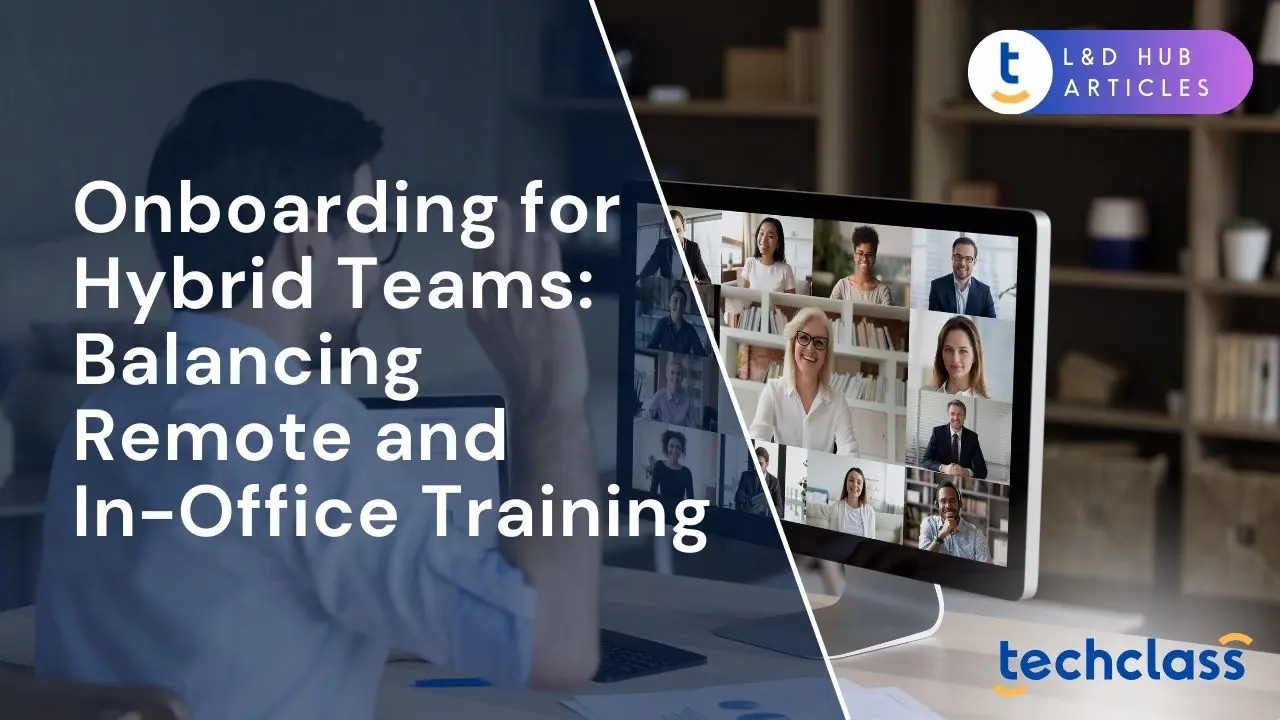Navigating the Hybrid Onboarding Landscape
In today’s post-pandemic workplace, hybrid teams, where some employees work on-site while others work remotely, have become the norm. This shift has revolutionized traditional onboarding. Companies can no longer rely solely on in-person in- person orientations or casual office meet-and-greets to integrate new hires. Yet effective onboarding is more critical than ever: Gallup finds that only 12% of employees strongly agree their organization does a great job of onboarding new hires. This is alarming because a a strong onboarding program can boost new-hire retention by 82% (and productivity by over 70%). In other words, how you welcome and train employees in those first weeks can make or break their decision to stay and thrive with the company.
Balancing remote and in-office training is tricky. HR professionals and business leaders must ensure that every new team member, whether sitting in headquarters or logging in from home, feels equally welcomed, informed, and supported. A recent survey highlighted that 37% of HR professionals view remote onboarding as their top hiring challenge, underscoring the need for new strategies. This article explores how organizations can overcome those challenges. We’ll examine the common hurdles of hybrid onboarding and outline best practices to create a seamless, secure, and engaging experience for all new employees, regardless of location.
The Hybrid Work Revolution and Onboarding Challenges
Hybrid work is here to stay. Organizations across industries have embraced flexible arrangements where employees split time between remote and in-office work. This revolution offers benefits, access to wider talent pools and increased flexibility, but it also complicates Employee Onboarding. Traditionally, onboarding new hires meant office tours, in-person introductions, and a day or two of on-site training. In a hybrid model, distance and asynchronous schedules can lead to new hires feeling isolated or missing out on crucial information. Common challenges in hybrid onboarding include:
- Communication gaps: Remote hires might miss the impromptu Q&As or overheard advice that in-office colleagues get. Without deliberate effort, they can feel “out of the loop.”
- Fragmented training experiences: Delivering training content consistently to both remote and on-site employees is difficult. There’s a risk of in-office hires getting richer, interactive sessions while remote hires get static documents.
- Technology and access issues: Ensuring every new hire has the right hardware, software, and network access from day one is a logistical hurdle. Nearly 47% of companies report struggling with onboarding due to infrastructure access challenges.
- Cultural integration: Perhaps the biggest challenge is helping new team members absorb the company’s culture and build relationships. Hybrid setups reduce face-to-face interaction, making it harder to foster that sense of belonging. New hires who don’t build strong bonds early on are at higher risk of disengagement or turnover. (In fact, about 20% of employees who quit do so within the first 45 days, often due to poor onboarding experiences.)
Recognizing these challenges is the first step. The good news: with careful planning, companies can overcome them and even leverage hybrid work advantages, like digital tools and global reach, to enhance onboarding.
Ensuring a Consistent Onboarding Experience for All
One key principle for hybrid teams is to offer the same onboarding experience to everyone, regardless of location. New hires should receive uniform messages about the company mission, values, and expectations, and have equal opportunities to meet colleagues and ask questions. Practical ways to ensure consistency include:
- Unified orientation sessions: Kick off onboarding with a virtual all-hands welcome. For example, hold a live video orientation where both in-office and remote hires can join, hear from leadership, and introduce themselves. This ensures every newbie hears the same story about the company’s history, culture, and goals. Supplement virtual sessions with recordings or transcripts for those in different time zones.
- Standardized content: Provide a centralized onboarding portal or learning management system (LMS) where all new hires access the same training modules, videos, and documents. This prevents any information from being siloed to just “office” or “remote” staff. A well-structured checklist of tasks (setting up accounts, completing HR forms, mandatory trainings) should be digital and accessible to all.
- Inclusive scheduling: If you organize live training workshops or team meet-and-greets, be mindful to include remote employees. For instance, if on-site hires tour the office and meet people face-to-face, remote hires can join via video or have virtual meet-and-greet calls scheduled. Some companies fly remote hires in for an “on-site week” early in their tenure, if feasible, this can jump-start personal connections. Alternatively, consider onboarding in cohorts so that a group of new employees (remote and co-located) go through the process together, instantly giving them a peer network.
- Personal touches for remote hires: To avoid a purely “plug in the laptop and go” feel, add non-virtual elements that mirror the warmth of an in-office welcome. This could mean mailing a welcome package (company swag, handwritten welcome note, etc.) to remote joiners, or scheduling a team lunch over video where food is delivered to them. Little gestures help remote employees feel as valued as those who shake hands on day one.
Above all, consistency requires planning. HR teams should map out the onboarding journey to ensure no one falls through the cracks. Every new hire, whether remote in another country or sitting at HQ, should finish their first week with a common foundation of knowledge and a sense that “I belong here.”
Leveraging Technology for Hybrid Training
Technology is the great enabler of hybrid onboarding. With the right tools, remote and in-office employees can learn, collaborate, and connect almost as easily as if they were in the same room. Organizations should leverage modern platforms to deliver training content and foster interaction across distances. Key approaches include:
- Interactive virtual training: Replace dry PDF manuals with engaging multimedia content. Live video webinars, interactive e-learning modules, and discussion forums can replicate classroom energy. For example, a live Zoom or Teams session with screen-sharing and Q&A can walk all new hires through using the company’s internal systems. Recording these sessions also allows flexibility for those who cannot attend in real-time.
- Collaboration tools: Encourage new hires to get comfortable with the team’s digital communication tools from day one. This might involve a mini-tutorial on how to use Slack/MS Teams channels, project management software, or the company intranet. By actively using these tools during onboarding (for instance, having new hires introduce themselves on a Slack channel), you both train them on the tool and help them connect. Microsoft’s experience during the pandemic showed that features like persistent chat, live polls, breakout rooms, and even “Together mode” (which puts participants in a shared virtual auditorium) can make remote onboarding sessions more engaging. Take advantage of these interactive features to keep trainees involved.
- Digital resources hub: Set up an easily accessible repository of resources. New employees, especially remote ones, can’t swivel their chair to ask a question. Instead, they should know where to find information on-demand. This could be an online handbook, an FAQ site, or an employee experience platform that consolidates communications, learning resources, and company knowledge. (For example, Microsoft directs new hires to an internal platform that even includes a glossary of company acronyms for quick reference.) A searchable knowledge base empowers hires to self-serve answers to many common questions anytime.
- Asynchronous learning: Hybrid teams often span time zones. Provide recorded trainings and self-paced learning modules so each hire can progress at their own comfortable pace, without missing content. You might designate certain courses (e.g. compliance or product training) as asynchronous modules that a new hire can complete within their first month. Pair this with checkpoints, say, a short quiz or a follow-up call, to ensure understanding.
By investing in robust technology for onboarding, companies not only make training more accessible but also signal to new employees that they are a modern, connected organization. The goal is to make remote hires feel just as immersed in the learning experience as those sitting in a training room.
Fostering Engagement, Culture, and Connection
Onboarding is about people, not just processes. For hybrid teams, HR and managers must work extra hard to foster personal connections and convey company culture. New hires who feel connected to colleagues and aligned with the culture are far more likely to stay engaged and stay on board. Here are strategies to humanize hybrid onboarding:
- Manager involvement: The relationship with one’s manager is critical for any new employee, and even more so when other interactions are limited. Managers should be actively involved from day one, providing guidance, context, and frequent check-ins. Microsoft found that when managers play an active role in onboarding (e.g. regular one-on-one meetings to coach and align expectations), new hires were 3.5 times more likely to report being satisfied with their onboarding experience. Early and regular manager check-ins, even a 15-minute daily touch-base in the first week, help newcomers feel supported. Managers should clarify role expectations, set short-term goals, and encourage questions to remove uncertainty.
- Onboarding buddy system: Pair each new hire with a buddy, an experienced colleague who can provide informal help and friendship. This is especially beneficial for remote employees who can’t turn to a neighboring cubicle for advice. A buddy can virtually walk the new hire through how things really get done, introduce them to others, and be a go-to for “dumb” questions. This system has proven results: at Microsoft, new hires with an effective onboarding buddy were more satisfied and got productive faster; those who met their buddy frequently (4–8 times in first months) saw rates of feeling quickly productive jump from 56% to as high as 86–97%. Clearly, every new employee should have an onboarding buddy to ease their integration.
- Team integration and culture sharing: Make sure remote folks feel like part of the team, not lone satellites. Arrange intentional meet-and-greets: one-on-one video introductions with key teammates, virtual team lunches or coffee breaks, and inclusion in any in-office social events via video (even if it’s just someone carrying a laptop around to say hi). Also, spend time conveying the organizational culture and values. While it’s tempting to focus only on tasks and tools, help new hires understand the big picture, the company mission, the customer focus, the team’s norms and quirks. Some companies have culture sessions where leadership or long-tenured employees share stories that illustrate company values. Encourage new hires (remote or not) to participate in any culture-building activities like online game hours, Q&A with executives, or mentoring programs. The more relationships and context a new employee builds, the more they’ll feel “at home.”
- Group onboarding and peer support: If you hire in batches, onboard in a group when possible. Going through training with a cohort, even if interactions are virtual, gives new employees a shared experience and peer network. They can later lean on each other (via group chats or check-ins) to navigate the learning curve together. One HR best practice is to create a socialization plan: schedule activities over the first 30-90 days that intentionally connect the new hire to different people, not just their immediate team, but cross-functional colleagues, leadership, and maybe a new-hire peer group. These planned touchpoints combat the isolation that remote employees sometimes feel and help build the “organizational muscle” of knowledge sharing and teamwork.
Ultimately, a hybrid onboarding program should be human-centric. Empathy and frequent communication go a long way. Encourage leaders and teammates to be welcoming and accessible. When new hires see that managers make time for them and colleagues reach out, they start forming the bonds that glue them to the organization. In hybrid settings, you have to design for these moments, they won’t happen by the water cooler, so plan them intentionally. The payoff is a more engaged, connected workforce from day one.
Security and Compliance Considerations
A often-overlooked aspect of onboarding hybrid employees is security. CISOs and IT leaders know that new hires can pose security risks if not properly trained, especially when those hires are remote, using devices outside the office network. Onboarding is the ideal time to instill good security practices and ensure all compliance requirements are met. Important steps include:
- Secure account setup: Before a remote hire’s first day, IT should provision all necessary accounts, logins, and devices with proper security controls. This includes setting up company laptops with VPN access, firewall and antivirus protection, and ensuring multi-factor authentication (MFA) is enabled on all accounts. New employees should not be left fumbling to install security software on their own; it should be pre-configured for them. Ideally, ship equipment in advance so that by Day One, the employee has a ready-to-go, secure workstation. IT can even schedule a brief video call on the first morning to walk the new hire through connecting securely and reviewing IT policies.
- Cybersecurity training from day one: No onboarding plan is complete without equipping employees to handle cyber risks. Include a security orientation as part of the training agenda, even if just 30 minutes covering the basics. New hires (remote or on-site) should learn how to recognize phishing emails, the importance of strong unique passwords and using password managers, data classification rules, and what to do if they suspect a security incident. Human error accounts for a large portion of breaches, so educating employees early is key. Emphasize that remote workers might be targets for phishing or social engineering since attackers know they’re not under direct supervision. Teaching them to be vigilant protects both the individual and the company.
- Policies and compliance: Ensure new hires read and acknowledge critical policies, such as data protection, acceptable use, remote work guidelines, and any industry-specific compliance policies (e.g. HIPAA, GDPR). Provide these in the onboarding portal and have a discussion or quiz to confirm understanding. For highly sensitive roles or industries, you may need additional verification steps. As a practical tip, sharing the company’s data protection policies and cybersecurity guidelines upfront sets a tone that security is taken seriously. It’s also wise to explain why these measures matter, so employees see security as part of their job, not just red tape.
- Protecting remote work environments: Advise remote employees on securing their home office. This includes using secure Wi-Fi (with encryption and strong router passwords), keeping devices locked when not in use, and separating work and personal accounts. If the company supports it, consider providing privacy screens or security keys to remote staff handling sensitive data. Make sure they know how to contact IT help quickly for any issues. Some organizations even conduct a brief “remote workspace security” check-in during onboarding: verifying the new hire has updated their system, enabled auto-lock, etc., as guided by IT.
- Compliance in training delivery: If you are in a regulated industry, ensure that mandatory training (like safety, anti-harassment, or privacy training) is delivered to all employees and that completions are tracked. Remote status should not exempt anyone from required training. Use e-signatures or learning system records to document that the new hire completed these modules.
By embedding security and compliance into onboarding, you not only reduce risk but also empower new hires to protect themselves and the company. One security industry article put it well: “Many remote workers use personal devices, which can be more vulnerable to attacks. Set them up for success by providing cybersecurity training that prepares them to protect sensitive company data from day one.” For CISOs, this is music to the ears, it means the organization is building a security-first culture right from a new employee’s first click.
Gathering Feedback and Continuously Improving
Onboarding doesn’t end after a week; it’s a continuous journey that can always be improved. Leading organizations treat onboarding as an evolving program, they measure its effectiveness and adapt over time. Unfortunately, over half of organizations do not formally evaluate their onboarding outcomes, which is a missed opportunity. To avoid stagnation and ensure your hybrid onboarding stays effective, consider these practices:
- Solicit new hire feedback: Within the first month and again after three months, ask new employees for their candid feedback on the onboarding process. Short surveys or informal check-in calls can uncover what worked well and what gaps remain. Did they feel included despite being remote? Was any training unclear? Were there tools or info they wish they had earlier? This input is gold for refining your program. And because hybrid work is relatively new for many, you might discover insights specific to remote vs. in-office experiences. For example, remote hires might say they felt lonely until a virtual team event occurred, a cue to schedule that earlier next time.
- Track key metrics: Look at objective indicators of onboarding success. These can include new hire retention rates (are fewer people quitting within 6 or 12 months?), time-to-productivity measures (how quickly are new hires fully performing their roles?), and engagement scores from pulse surveys. If hybrid onboarding is working, you’d expect to see strong early retention and positive survey responses about feeling welcomed and prepared. If you spot troubling trends (e.g. remote hires consistently scoring lower on “I feel connected to my team”), it’s a signal to adjust parts of the process.
- Involve leadership and cross-functional input: Ensure that refining onboarding isn’t just an HR task done in a vacuum. Get managers’ perspectives, since they are deeply involved, and involve executives or department heads in reviewing the program periodically. It’s notable that only 35% of organizations involve leadership in onboarding programs, yet leadership engagement can elevate the importance of onboarding and secure resources for improvement. Leaders can also contribute by meeting new hires (even briefly) to give a warm welcome, which reinforces the program’s impact.
- Update content and format: As your company grows or policies change, keep onboarding materials up to date. Hybrid work itself may evolve (for instance, new collaboration tools might replace old ones, or policies may shift on office attendance). Regularly audit your onboarding checklist and content to ensure it reflects the current reality. If new tools or best practices emerge, say, a better virtual whiteboard app for training or a more engaging e-learning platform, be ready to adopt them. The aim is to keep the onboarding experience fresh, relevant, and aligned with how work gets done in your organization today.
- Pilot and iterate: Don’t be afraid to pilot new onboarding initiatives with a small group. Maybe you try a “mentor rotation” program where, over their first month, a new hire has one-on-ones with people from different teams. Gauge the results and feedback, then iterate. Hybrid onboarding is still a learning process for many companies; continuous improvement mindset will help you stay ahead of the curve.
By measuring and tweaking your approach, you demonstrate a commitment to making onboarding the best it can be, which ultimately benefits both employees and the business. Effective onboarding not only reduces costly early turnover but also builds a stronger, more cohesive workforce faster. In a hybrid world, that cohesion doesn’t happen by accident; it’s achieved by deliberately learning and improving the onboarding craft.
Final Thoughts: Embracing a Balanced Approach
Hybrid team onboarding is a balancing act, blending the high-touch, personal elements of in-office training with the flexibility and reach of remote learning. Done right, it can truly offer the best of both worlds. New hires get the comprehensive, consistent training they need, and the personal connections and cultural immersion they crave. Achieving this balance requires intention: planning every step of the onboarding journey to be inclusive and engaging for all, whether someone is sitting in a conference room or at their kitchen table.
For HR professionals, CISOs, and business leaders, the message is clear. Onboarding is not a mere formality or a one-day orientation; it is a strategic investment in your people. In hybrid environments, it pays to think of onboarding as an experience rather than a checklist. From the moment a candidate says “yes” to the job offer, through their first 90 days, we must orchestrate experiences that welcome them, educate them, protect them, and inspire them. By adopting the practices discussed, from assigning buddies and leveraging tech to reinforcing cybersecurity and gathering feedback, organizations set their hybrid teams up for long-term success.
Remember that a new employee’s enthusiasm is never higher than in those early days. By channeling that excitement with an onboarding program that balances remote and in-office training effectively, you affirm their choice to join your team. They’ll feel connected, empowered, and ready to contribute, no matter where they work. And when onboarding succeeds, so do your employees, leading to higher engagement, better performance, and improved retention for the enterprise. In an era where great talent can work from anywhere, companies that excel at hybrid onboarding will have a distinct advantage in building a committed, high-performing workforce.
FAQ
What is hybrid onboarding and why is it important?
Hybrid onboarding is the process of integrating new hires and cross-training staff in workplaces that combine remote and in-office roles. It’s important because it ensures all employees receive consistent training, feel included, and are equipped to perform effectively, regardless of location.
How can companies ensure consistency in onboarding for remote and in-office employees?
Organizations can maintain consistency by offering unified virtual orientations, standardized training materials via an LMS, inclusive scheduling for sessions, and personalized touches like welcome packages for remote hires.
What role does technology play in hybrid onboarding?
Technology enables interactive virtual training, collaboration through platforms like Teams or Slack, centralized resource hubs, and asynchronous learning options. These tools help ensure remote hires have equal access to information and engagement opportunities.
How can companies foster culture and connection in hybrid onboarding?
Fostering culture involves active manager involvement, assigning onboarding buddies, arranging intentional meet-and-greets, hosting virtual social events, and creating opportunities for cross-team interaction, so all hires feel connected to the organization.
Why should security and compliance be part of onboarding?
Including security and compliance training from day one protects company data, reduces risks, and ensures employees understand critical policies. This is especially crucial for remote hires using personal devices or working outside the corporate network.
References
- Gallup. Why the Onboarding Experience Is Key for Retention. Gallup Workplace; c2019. Available from: https://www.gallup.com/workplace/235121/why-onboarding-experience-key-retention.aspx
- Lau G. 25 Surprising Employee Onboarding Statistics in 2025. StrongDM; 2025. Available from: https://www.strongdm.com/blog/employee-onboarding-statistics
- Microsoft WorkLab. Strategies for Onboarding in a Hybrid World. Microsoft; c2021. Available from: https://www.microsoft.com/en-us/worklab/strategies-for-onboarding-in-a-hybrid-world
- Veriff. How to Onboard Remote Workers: A Guide to Safely Ensuring Their Identity. Veriff; c2023. Available from: https://www.veriff.com/identity-verification/business/onboarding-remote-workers-identity-verification
- MIT Human Resources. Onboarding in Remote/Hybrid Work Environments. Massachusetts Institute of Technology; c2021. Available from: https://hr.mit.edu/managers/remote/onboarding
Weekly Learning Highlights
Get the latest articles, expert tips, and exclusive updates in your inbox every week. No spam, just valuable learning and development resources.



